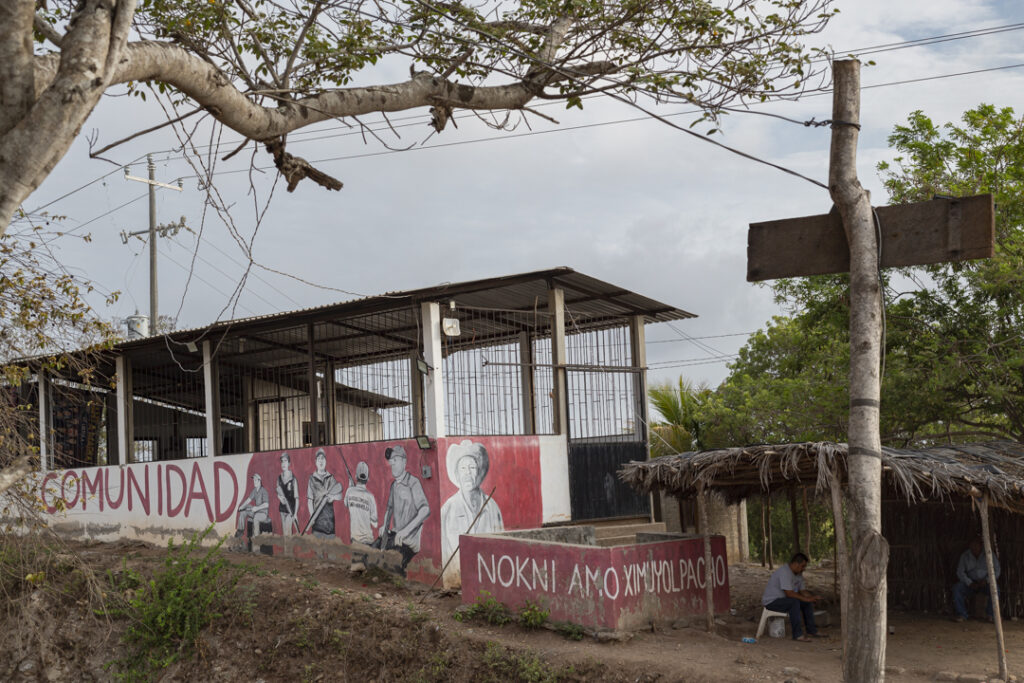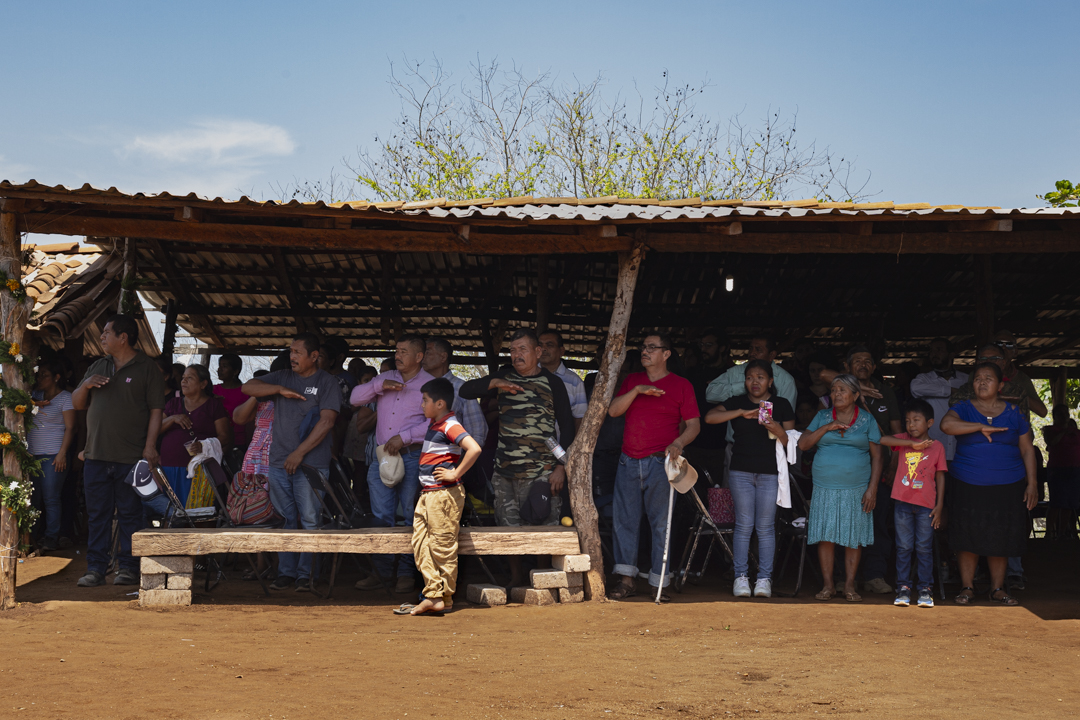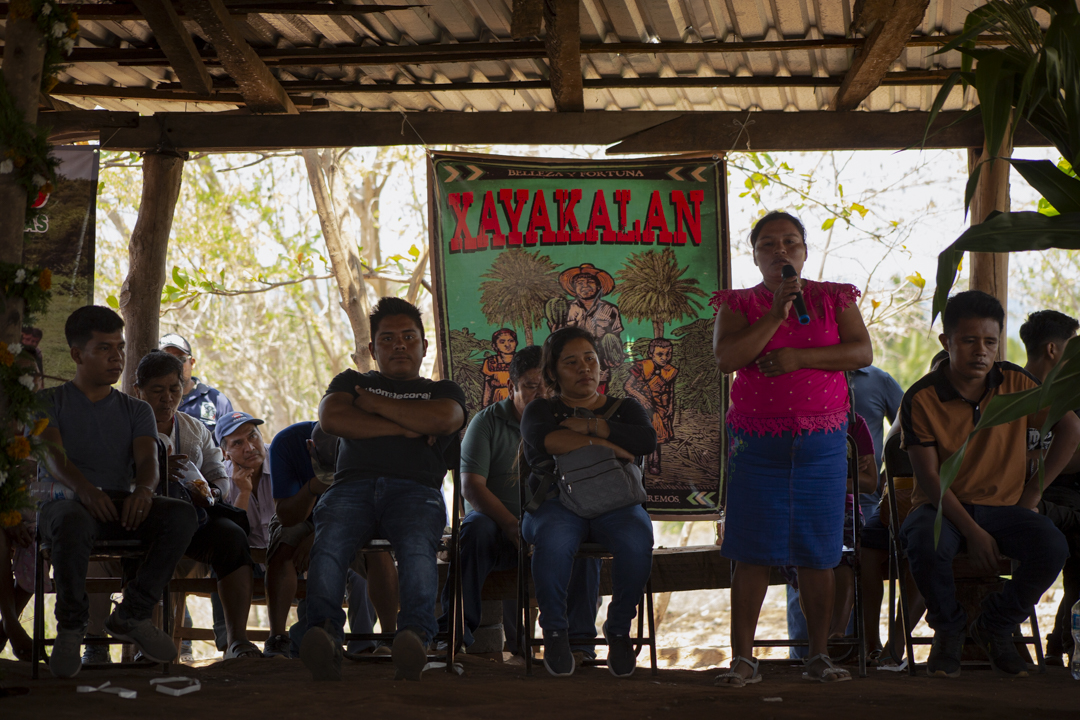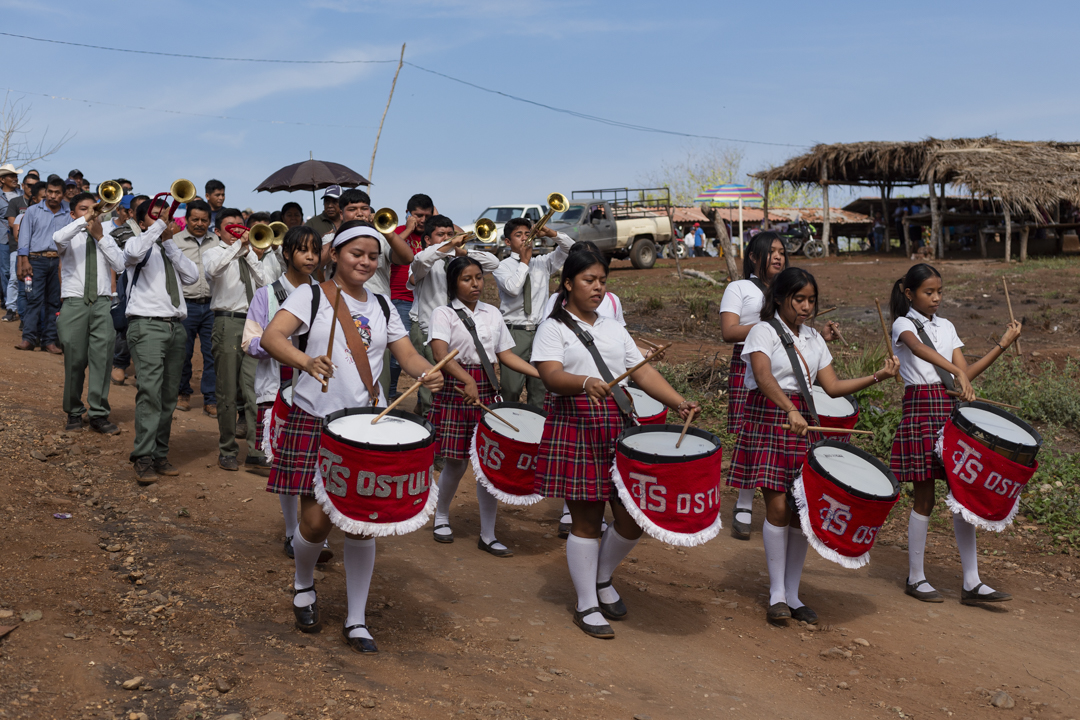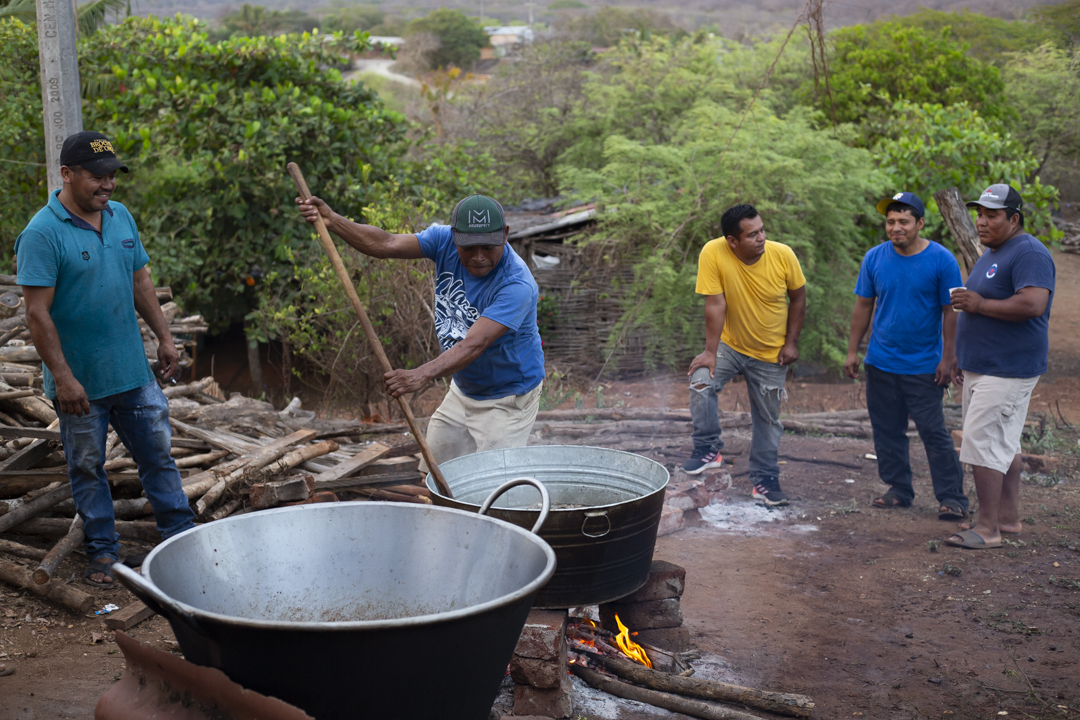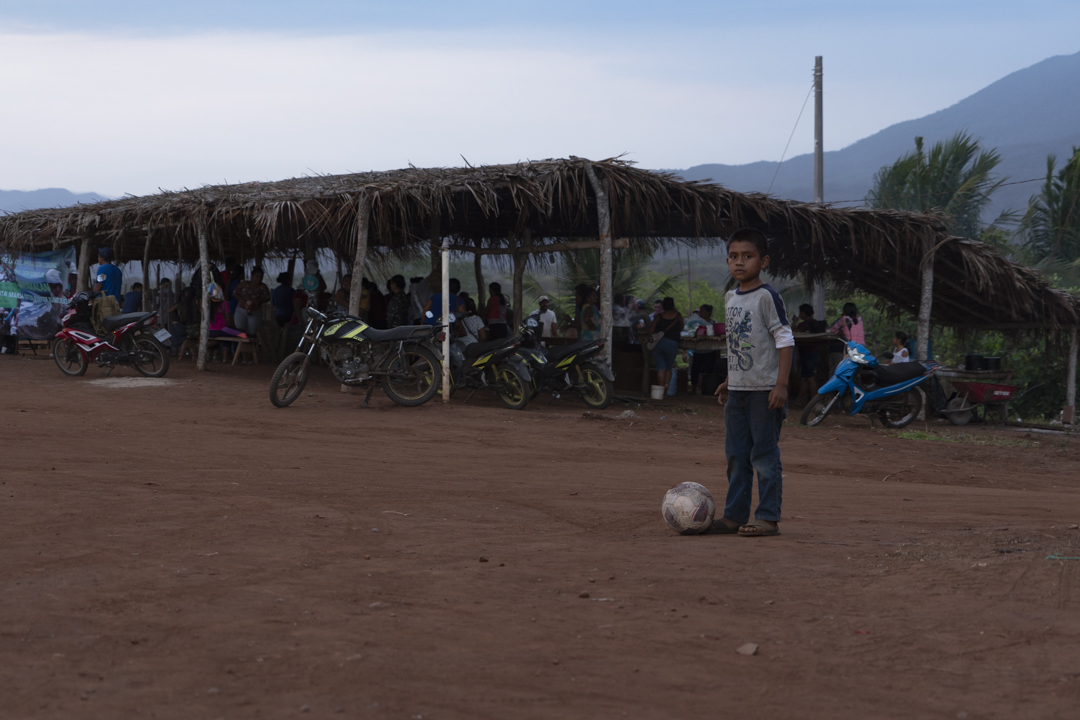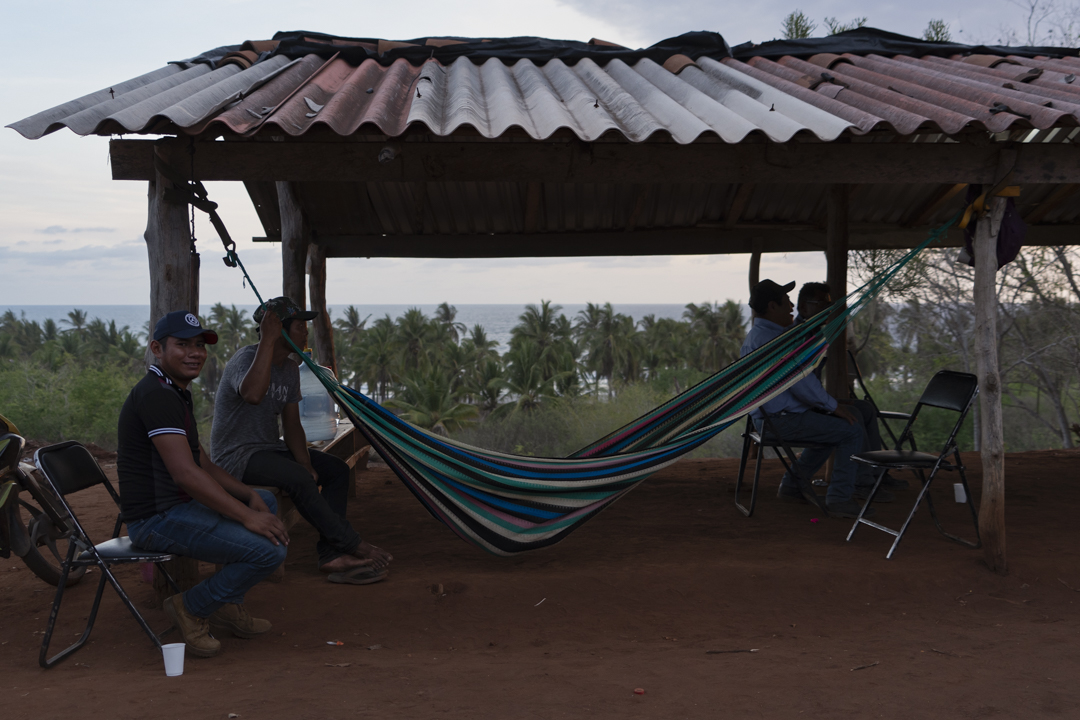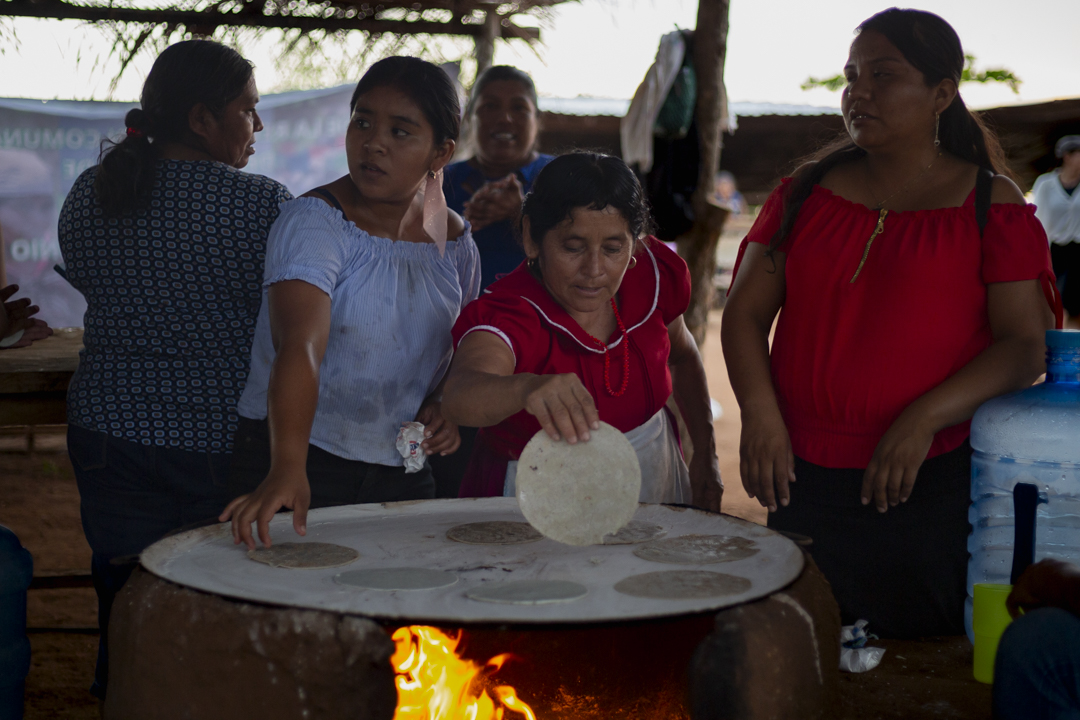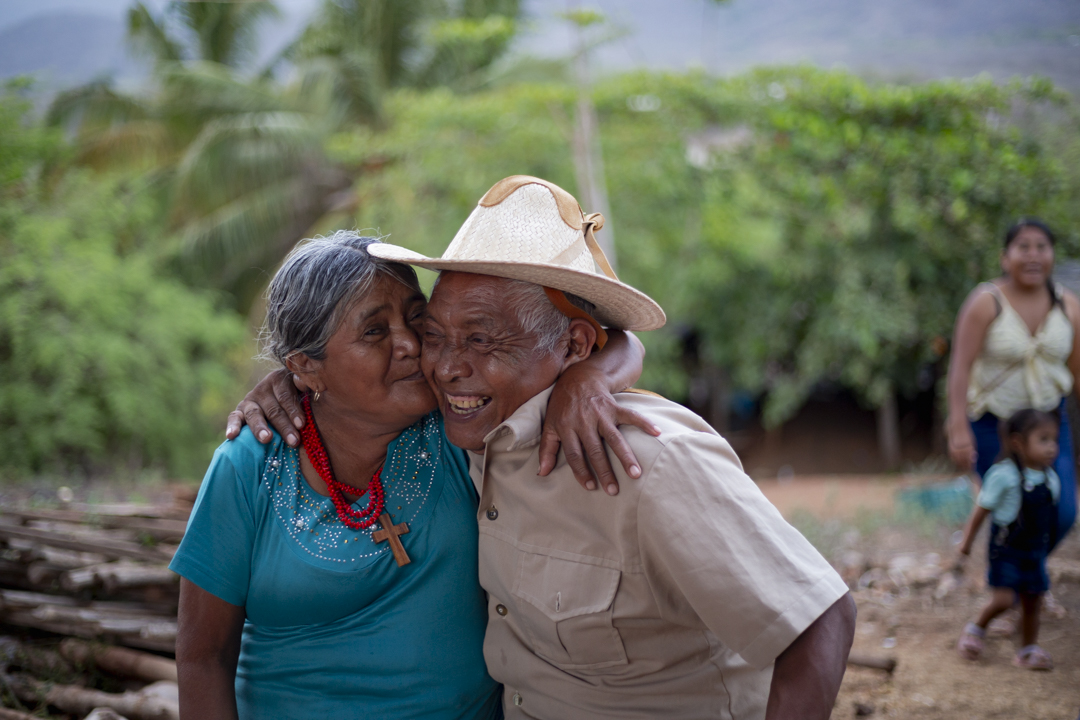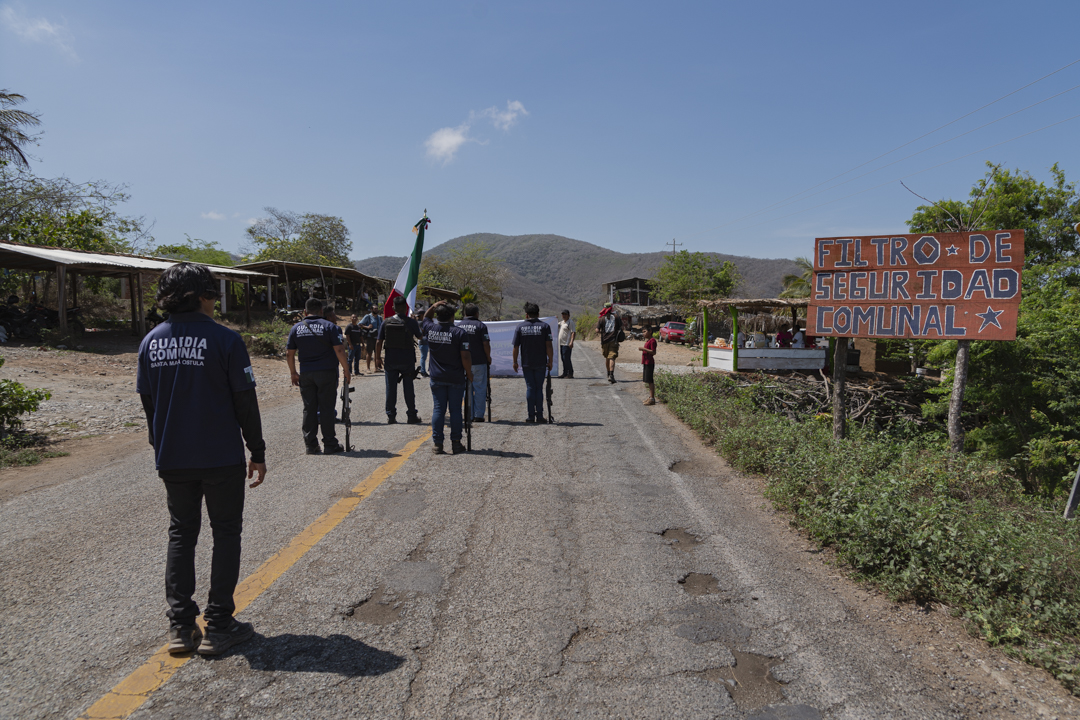Cover image: The communal guard of Ostula is a voluntary service provided to the community. Each member is elected in the encargaturas and the service lasts one year. Photo: Regina López
By Santiago Navarro F and Regina López
She is known as La Mexicana. She is an Indigenous Nahua woman, over fifty years old. In her firm stare she holds like a secret the most decisive moments in the last fifteen years of her life “doing resistance” as she says. She’s learned how to overcome the threats from organized crime on her lands. First it was the Familia Michoacana Cartel, she says, then it was the Knights Templar Cartel, and now the Jalisco New Generation Cartel (CJNG).
Her name is Teresa Regis Nicolás. She returned from the United States fifteen years ago. After the death of her father, she returned to her native land with the legacy that he left her, to struggle for the communal lands that belong to the Indigenous people of Santa María Ostula, in municipality of Aquila, located in the state of Michoacán. These lands extend to the pacific coast, in the western part of Mexico.
It was 2009. It had only been three months since the community had carried out an armed recuperation of a fraction of their lands. Today, Teresa, her children, and more than 70 Indigenous families live on the recuperated territory. The lands are now known as Xayakalan. Prior to the recuperation, they were in the hands of landowners who had acquired property titles and were connected to organized crime. The Indigenous people have titles for their communal lands from a presidential decree from 1964, and today the primordial titles from the 1700’s that prove the land to be theirs.
Xayakalan became village number 24 that of Ostula, what the local people call encargaturas, similar to municipal agencies. “I wasn’t involved in the recuperation of the lands. But three months later, I was one of the first eight families that settled here with a small home. Since then, we have resisted,” remembers La Mexicana.
Community members recount that since 1997 they had been preparing these lands to be planted, before they were taken over by landowners.
In June 2003 they decided for the first time to physically establish themselves on the lands, constructing a series of adobe homes. In September of that same year, the homes were torn down. In 2004, the landowners sued the Indigenous people for usurping private property. “Afterwards the court ruled in favor of the landowners,” shares Evaristo Domínguez Ramos, a community member of Ostula.
In 2008, the Agrarian Court of Colima decided that these lands—highly productive and with a paradise-like beach—were property of those who had filed the lawsuits. According to the community members, these people were “linked at that time to the Knights Templar Cartel.”
From that moment on, for a year and two months, in silence, members of the communal council of Ostula began to organize a response. In general assemblies and collective meetings, each one of the 23 encargaturas were consulted about the idea of taking action to recuperate the lands. Afterwards, it was decided to name the lands Xayakalan. “That is how we began to struggle in defense. The decision was made in April 2008, we had to recuperate these lands,” shares Evaristo.
The brave action to recuperate the lands was organized by community members who maintained their plans secret, until the day of the recuperation when dozens of Indigenous men and women participated. “On June 29, 2009, the lands were retaken. It has not been easy, it has cost many lives,” he adds.
During these years of struggle, forty-four Indigenous people have been killed, and according to the Public Prosecutor’s Office of the State of Michoacan, between 2009 and 2014, there have been five disappearances. Among the disappeared is the 62-year-old communal lands commissioner, Francisco de Asís Manuel, who was kidnapped from his home in the village of Palma Sola.
It has been fifteen years now that the Nahua community has had control of their lands. On June 28 and 29, they celebrated the anniversary, remembering the dead and disappeared. They danced and sang accompanied by solidarity groups who have supported their struggle. Women and men also shared bits and pieces of memories of the most difficult moments they’ve lived through.

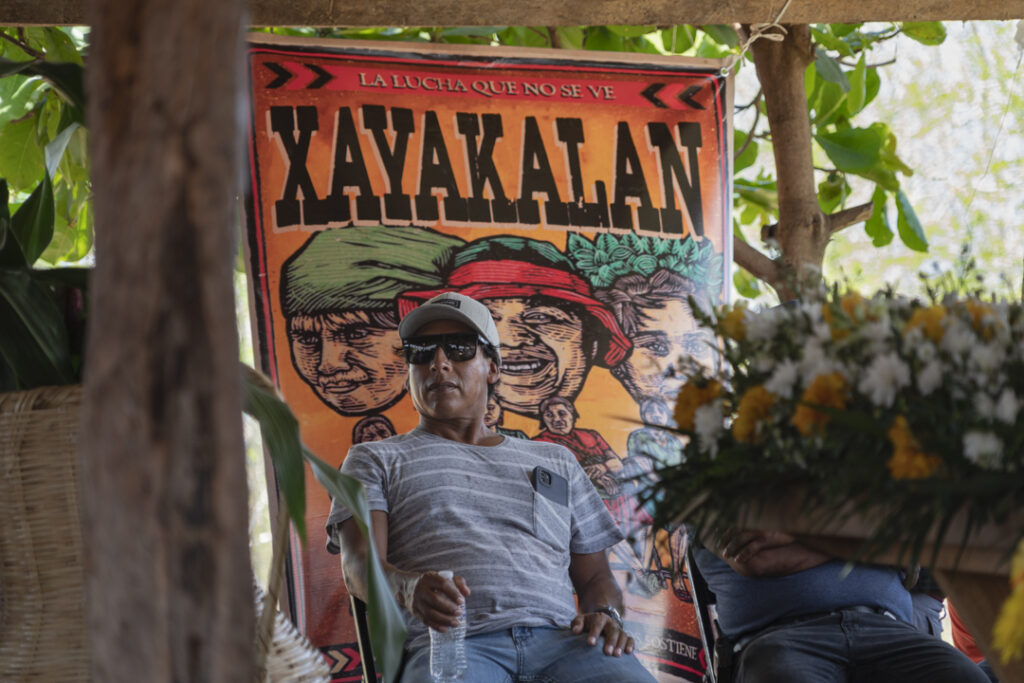
One of the participants at the event remembered that during the recuperation, on the Michoacán coast, it was crab season. It is common for the local people to go to the beach to collect crabs that come out during the rains. On the day of the recuperation, “We came across an armed commando who said to us, ´You Indian sons of bitches, there are no crabs here!´ Moments after, they shot toward us with ak-47 assault rifles. There were three elderly folks with us. One man stayed behind. He said to the armed men, ´kill me if you want. I’m not afraid´.”
This campesino from La Labor, who participated in the recuperation of the land recounts, “We were the first to arrive. We held our ground for fifteen days, until there was no more food. Women arrived with only charalitos (small fish), and fifteen years later, we continue the struggle,” shares the Indigenous man.
Teresa lived the everyday experience after the recuperation. A lump develops in her throat, she gathers her courage and explains, “We’ve been through difficult times, sad times, frightful times, but also beautiful times, like the mutual aid in the community. At first, we were many families, and at a certain moment the resistance was weakened to the point where there were only eight families. Today it is truly a community,” she shares while letting off a smile seeing the children that have been born on these recuperated lands, which now count more than double the population of the adults.”
Teresa, like the rest of the women in Xayakalan, is cheerful because it is a day of celebration, the fifteenth anniversary of the recuperation of the lands. The children run and blend in with the landscape near the ocean. The wind that brings the waves to the beach, also brings the smell of food to the entire community. “It is time to celebrate that we are still alive. To remember our dead, so that we never give up the struggle,” says La Mexicana.
In the new community of Xayakalan, the only way to survive was to make life. New couples emerged who decided to struggle together, having children while resisting constant attacks from organized crime. Today there are more than 70 families who live together in the community, their children go to the new school, and they’ve also built a church. Everyone has a house and two parcels to farm.
Teresa explains with pride, “My son is from here, he was born here, his umbilical cord is buried here. There are now more than 150 children in the community. We have the responsibility of teaching them the extension of our lands, just as our grandparents did. I’ve taken my son all the way to the peripheries of Ostula, so he will never forget,” she shares.
On August 11, 2023, the community received a judicial notification of a “forced rectification of limits” of the lands. This would imply the entrance of governmental personal to rectify the properties of those who had filed lawsuits—the landowners—with the latent intervention of the National Guard and the Military.
This ruling was emitted by Judge Arturo Bernal Lastiri, who has also been accused by the Indigenous Nahuas of San Miguel de Aquila, of supporting an unknown lands commissioner, who is allowing the exploitation of minerals in the region. They mobilized for his removal in 2022 with a protest at the offices of the Local Agrarian Court 48 of Colima.
Before this legal resolution was handed down, there was a prolonged legal process lasting a decade, from 2009-2019. This legal process began at the time of the recuperation of the 1,200 hectares that today they have converted into Xayakalan. At the time, in 2009, the court ruled in favor of re-ratifying measurements, taking into account fixed landmarks, like the ocean, mountains, and rivers.
Despite the addition of the new elements of evidence—including the primordial titles which date back to the 1700s, and which detail the limits of the territory of Ostula extending beyond the disputed strip—the court ruled in favor of the landowners. They retook old measurements, which “are wrong”, says the lawyer of the community, Carlos Gonzales.
Then arrives February 2023, following a new request from Ostula for a review of the sentence handed down in 2019, and another appeal. By August 2023, Judge Bernal Lastiri once again ruled in favor of the landowners, ordering the forced intervention in Xayakalan.
Jeronimo Flores, member of the communal council, explains: “We mobilized and they never came to execute the order. We imagine that they realized our organization is very solid.”
Indeed, it is. In August 2023, more than 600-armed Indigenous people were deployed both inside Xayakalan as well as outside its boundaries, to impede any intervention into their territory. Afterwards, “the court decided to suspend the forced execution of the order,” with an amparo numbered 463/2023, explains the community’s lawyer to Avispa.
However, this amparo only temporarily suspends the intervention until a new ruling is handed down. If they do not get a response in favor of Ostula at this court, they will have to look for options at the international level. “Regardless, nobody will remove us from Xayakalan,” says Teresa, who has been threatened with death and directly harassed by organized crime.
She explains that the community is more organized than ever: “We are safe because we have our communal guard. Here, not the army, nor the marines, nor any governmental force enters into our community without permission.”
State armed forces cannot enter these territories, unless “the community permits it. That is what was agreed upon in an assembly. Instead of helping, they come to trample on our communities, like the child who was assassinated. There are antecedents. In 2011, the army was working directly with organized crime,” adds Jeronimo.


Autonomous Security
One of the principal strengths of this process of resistance is its communal guard and its capacity for rapid mobilization. The community member Evaristo details that “communal guard members are named by each encargatura in their assemblies,” each one is armed and prepared for whatever type of aggression.
The council member Jerónimo shares that, in case of a crisis or emergency, “all the guards of each encargatura are activated. We all have to get involved. It is an obligation to defend ourselves. We’ve already lived through moments of crisis, and we don’t want them to happen again.” Teresa was the first woman to be named by the new community of Xayakalan as representative of its inhabitants. “I was appointed the head of community security in 2018. You are the one organizing the security of the community, yet everyone participates. If there is a problem, a collective work day, or even a party, we resolve it collectively,” says Teresa, who did one year of service and afterwards integrated into the rest of the community activities, like taking turns accompanying the security checkpoint with the communal guard.
The guards stopped existing in 1999, leaving just the state police in charge of security. “The community said, we need to organize our own community police because the situation is going to get difficult. Afterwards they were renamed communal guards. With them we recuperated the lands and now they watch over the security of Ostula,” says Evaristo.
It is well known by inhabitants of the surrounding communities that this zone was occupied by the Knights Templar cartel as a base of operations. On this beach arrived boats to unload drugs.
After retaking the lands, they threatened Teresa. “I remember that a man they called Chalano (Prisiliano Corona Sánchez) threatened me with a rifle to my back. I just waited to see what would happen. It was a very difficult time, the community had been weakened,” she explains
In addition to Chalano, community members who withheld their names for security reasons, accuse Iturbide Alejo, known as El Turbinas, and Margarita Pérez, known as La Usurpadora, for threatening to kill Trinidad de la Cruz Crisóstomo, alias Don Trino. He was afterwards assassinated in December 2011.
In addition to organized crime, the area where Xayakalan is located is part of the Regional Plan for Integral Tourist Development of the Coast of Michoacan; a tourist corridor seeking investments to build resorts for national and international tourism.
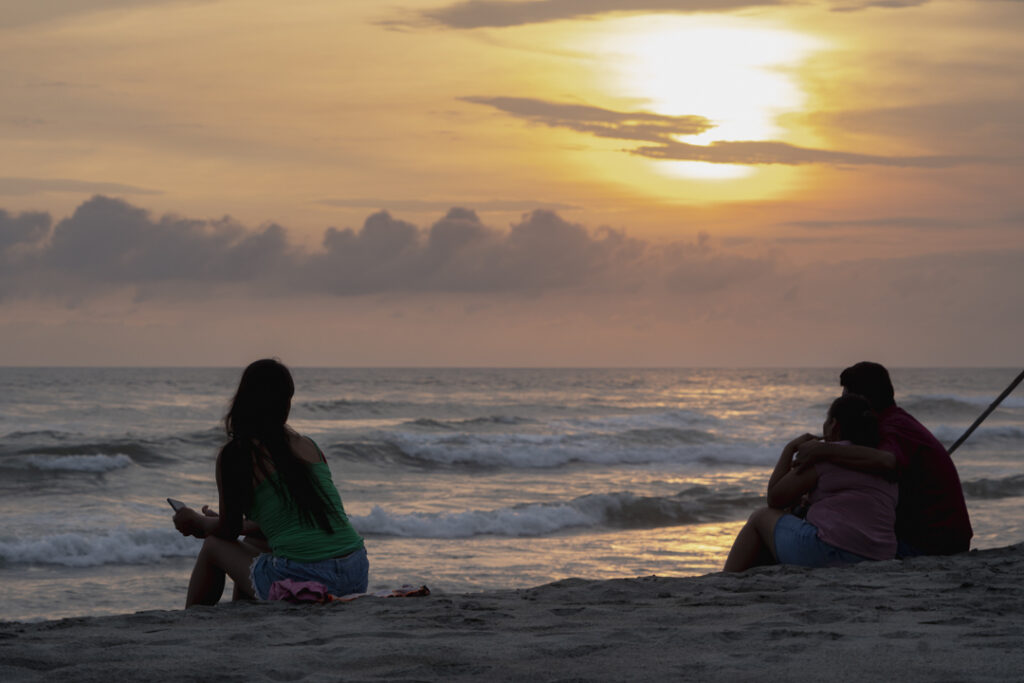


According to the strategy presented by the Secretariat of Tourism during the administration of Felipe Calderon 2006-2012, where the lands have been recuperated there were plans for a real estate development project, golf courses, stores, an aquatic park, museums, night life, and restaurants.
The Avispa Team also reviewed the data of active mining concessions, solicited from the Secretariat of Economy. We found that just in Aquila alone, where Ostula is located with its twenty-four encargatures, there exists fifty-three mining concessions. At least sixteen belong to Las Encinas S.A. de C.V., property of the steel company Ternium, S.A. Ternium is the steel and metallurgical company with the highest turnover rates in Mexico in 2022, mainly from the sale of steel.
This company is directly linked to the Jalisco New Generation Cartel and with the disappearances of the lawyer Ricardo Lagunes Gasca and a community leader of Aquila, Antonio Díaz Valencia. According to an investigation carried out by the media outlet, A Donde Van los Desaparecidos, these disappearances are linked “with the social and legal struggle they (the activists) have maintained against Ternium since 2019.”
This same cartel maintains constant attacks on the encargatura La Cofradía, where there are at least two mining concessions: 223431 belonging to Ternium, and 217537 belonging to Servicios Minerometalurgicos de Occidente, S.A. de C.V. which together total more than 2,500 hectares.
In the municipality of Aquila, Ternium has more than 147,000 hectares of land concessions, according to information solicited from the Secretariat of Economy.
The lands of this Indigenous community are rich in minerals, wood, and other natural resources. This wealth is under dispute between different organized crime groups. Through years of struggle, “At all times we have been on constant alert,” says Jeronimo.
You might be interested in- Alert! Santa María Ostula Under Attack Again from the Jalisco New Generation Cartel
Don Evaristo explains that the communal guard has to always be on alert “Because our security depends on them. We have to teach the youth because their participation is necessary, so that they can provide their services to the community.”
“We already endured years of attacks from different cartels, and we aren’t going to let down the guard. We will continue organizing and resisting, defending our lands,” adds Jeronimo.
For Teresa, it is important to strengthen the organization, “Because if we are united, they can’t do anything to us. The organizing must never end, we have to provide an example to our children, grandchildren, and all the kids, so that the organizing never comes to an end,” she shares at the celebration of the fifteenth anniversary of Xayakalan.
Just a couple days after the anniversary festivities, the community denounced in a communique that “the Jalisco New Generation Cartel” attacked “with brutal violence the Indigenous community of Santa María Ostula,” principally the encargatura of La Cofradía. This attack was more aggressive than previous ones, with drones and high caliber weapons used against houses, a school, and common spaces during the night of July 3. The attacks have been constant and the government doesn’t seem to care. For this reason, there is a saying on the murals and signs at the community organized security checkpoint: “In Ostula the struggle for security is permanent.”

